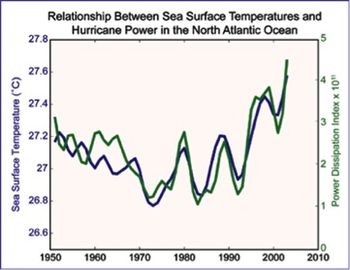SSTFlooding: Difference between revisions
| (9 intermediate revisions by the same user not shown) | |||
| Line 1: | Line 1: | ||
= Do High SSTs Increase the Risk of Flooding (and Sediment Overload)? = | = Do High SSTs Increase the Risk of Flooding (and Sediment Overload)? = | ||
[[File:SST_and_hurricanes.jpg|thumb|center|350px|Increasing SSTs result in stronger storms <ref><ins>http://nca2009.globalchange.gov/observed-relationship-between-sea-surface-temperatures-and-hurricane-power-north-atlantic-ocean</ins></ref>]] | |||
Increased sea surface temperatures do result in increased flooding and sediment overload. One result of increased sea surface temperatures is a shift in weather patterns and storm pathways. Another result of increased sea surface temperatures is increased storms due to a positive feedback loop starting with ice melting. Initially ice melts at the poles, increasing evaporation due to the darker surface area of water, which then increases humidity leading to more intense storms, more extreme precipitation, and stronger wind currents. Some areas because of increased evaporation will experience intense surface drying increasing the risk of flooding when these intense storms occur. The dry soil quickly reaches its saturation point and the excess water runs off into coral reefs carrying with it excess nutrients and [[sediment]]. <ref>Griffis, Roger B., and Jennifer Howard. Oceans and Marine Resources in a Changing Climate: A Technical Input to the 2013 National Climate Assessment. Washington: Island, 2013. Print.</ref> Coral reefs thrive in a nutrient poor environment, so the introduction of excess nutrients from storm water runoff damages coral reefs by promoting algal growth and causing a phase shift from coral dominated reef communities to algae dominated ecosystems. <ref>Wolanski, Eric. Oceanographic Processes of Coral Reefs: Physical and Biological Links in the Great Barrier Reef. Boca Raton: CRC, 2001. Print.</ref> | |||
== Notes == | == Notes == | ||
<references /> | <references /> | ||
Latest revision as of 16:35, 16 April 2014
Do High SSTs Increase the Risk of Flooding (and Sediment Overload)?

Increased sea surface temperatures do result in increased flooding and sediment overload. One result of increased sea surface temperatures is a shift in weather patterns and storm pathways. Another result of increased sea surface temperatures is increased storms due to a positive feedback loop starting with ice melting. Initially ice melts at the poles, increasing evaporation due to the darker surface area of water, which then increases humidity leading to more intense storms, more extreme precipitation, and stronger wind currents. Some areas because of increased evaporation will experience intense surface drying increasing the risk of flooding when these intense storms occur. The dry soil quickly reaches its saturation point and the excess water runs off into coral reefs carrying with it excess nutrients and sediment. [2] Coral reefs thrive in a nutrient poor environment, so the introduction of excess nutrients from storm water runoff damages coral reefs by promoting algal growth and causing a phase shift from coral dominated reef communities to algae dominated ecosystems. [3]
Notes
- ↑ http://nca2009.globalchange.gov/observed-relationship-between-sea-surface-temperatures-and-hurricane-power-north-atlantic-ocean
- ↑ Griffis, Roger B., and Jennifer Howard. Oceans and Marine Resources in a Changing Climate: A Technical Input to the 2013 National Climate Assessment. Washington: Island, 2013. Print.
- ↑ Wolanski, Eric. Oceanographic Processes of Coral Reefs: Physical and Biological Links in the Great Barrier Reef. Boca Raton: CRC, 2001. Print.